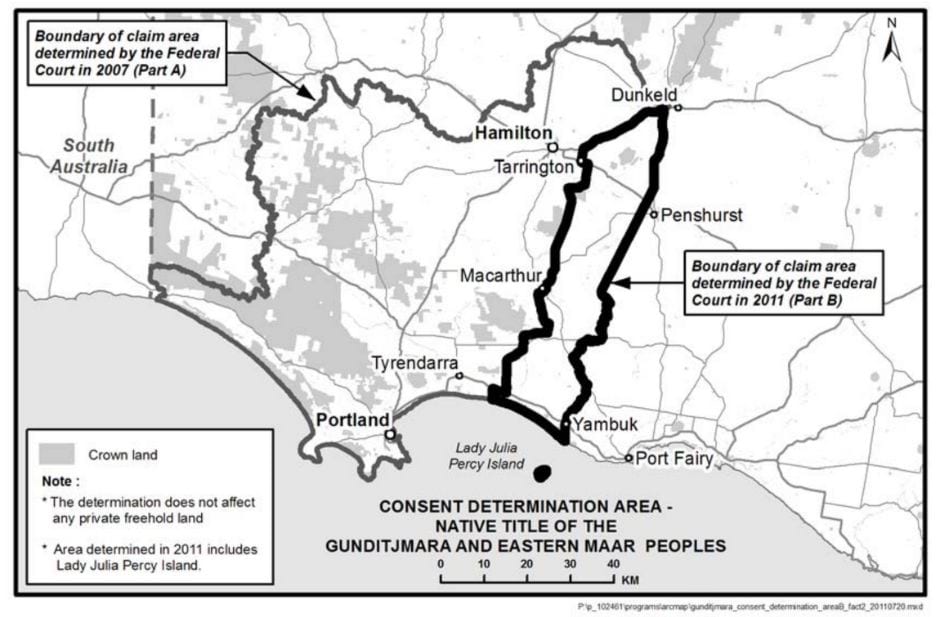On 27 July 2011, the Federal Court recognised that the Gunditjmara people and the Eastern Maar people hold native title over Crown land in the south west of Victoria.
What is the determination of native title?
Native title is the recognition in Australian law of Aboriginal people’s rights and interests in their traditional lands and waters. Aboriginal groups can apply to the Federal Court to have these rights recognised under the Native Title Act 1993.
In this case, the Federal Court recognised that the Gunditjmara People and the Eastern Maar People both hold native title over Crown land in the area shown on the map below. The State and all other parties to the claim have agreed to this finding, making it a ‘consent determination’.
The Gundijtmara People and the Eastern Maar People
The Gunditjmara and Eastern Maar Peoples are the traditional Aboriginal owners of this area of south-west Victoria. They are separate but related ‘domains’ of the same community of native title-holders. Membership of the Gunditjmara and Eastern Maar is defined by reference to criteria including descent from identified ancestors who occupied the area around the time of European settlement.
What native title rights do the Gunditjmara and the Eastern Maar have?
Under the consent determination, the Gunditjmara and the Easter Maar peoples have the native title right to:
- access to or enter and remain on the land and waters;
- camp on the land and waters landward of the high water mark of the sea;
- use and enjoy the land and waters;
- take the resources of the land and waters; and
- protect places and areas of importance on the land and waters.
These rights can only be exercised on Crown land and waters and are subject to relevant State and Commonwealth laws. These rights are the same as the rights recognised for the Gunditjmara in the ‘Part A’ area.
Does this affect the people with interests in the area?
Any existing interest-holders – such as people with licences over Crown land – are unaffected by this determination. In most cases, these interests will co-exist with the and native title rights. However, to the extent of any inconsistency, the existing interests prevail over native title rights.
As is already the case, some new activities on Crown land and waters require native title-holders to be notified beforehand. The Native Title Act 1993 sets out processes for addressing any impacts on native title where they occur.
Who will manage the native title rights in Part B?
In Part B, each of the two Peoples have nominated a corporation to manage the native title rights in the area. The Gunditj Mirring Traditional Owners Aboriginal Corporation (GMTOAC) will hold the native title on behalf of the Gunditjmara People and the Eastern Maar Aboriginal Corporation (EMAC) will be an agent on behalf of the Eastern Maar People. These corporations are called “prescribed bodies corporate” (‘PBCs’) under the Native Title Act.
Native title law permits two PBCs to hold native title rights and interests for the same area of Crown land, where the native title-holders choose this. There are precedents for this elsewhere in Australia.
The two PBCs have committed to working together to minimise any administrative complexity and cost for all parties in ‘future act’ and Aboriginal cultural heritage processes arising from having two PBCs.
Updated


